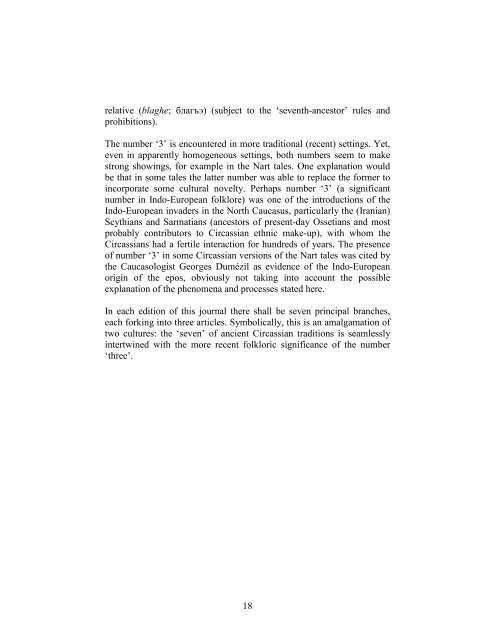Адыгэ пхъэлъантхъуэ / The Hearth Tree
Адыгэ пхъэлъантхъуэ / The Hearth Tree
Адыгэ пхъэлъантхъуэ / The Hearth Tree
You also want an ePaper? Increase the reach of your titles
YUMPU automatically turns print PDFs into web optimized ePapers that Google loves.
elative (blaghe; благъэ) (subject to the ‘seventh-ancestor’ rules and<br />
prohibitions).<br />
<strong>The</strong> number ‘3’ is encountered in more traditional (recent) settings. Yet,<br />
even in apparently homogeneous settings, both numbers seem to make<br />
strong showings, for example in the Nart tales. One explanation would<br />
be that in some tales the latter number was able to replace the former to<br />
incorporate some cultural novelty. Perhaps number ‘3’ (a significant<br />
number in Indo-European folklore) was one of the introductions of the<br />
Indo-European invaders in the North Caucasus, particularly the (Iranian)<br />
Scythians and Sarmatians (ancestors of present-day Ossetians and most<br />
probably contributors to Circassian ethnic make-up), with whom the<br />
Circassians had a fertile interaction for hundreds of years. <strong>The</strong> presence<br />
of number ‘3’ in some Circassian versions of the Nart tales was cited by<br />
the Caucasologist Georges Dumézil as evidence of the Indo-European<br />
origin of the epos, obviously not taking into account the possible<br />
explanation of the phenomena and processes stated here.<br />
In each edition of this journal there shall be seven principal branches,<br />
each forking into three articles. Symbolically, this is an amalgamation of<br />
two cultures: the ‘seven’ of ancient Circassian traditions is seamlessly<br />
intertwined with the more recent folkloric significance of the number<br />
‘three’.<br />
18




